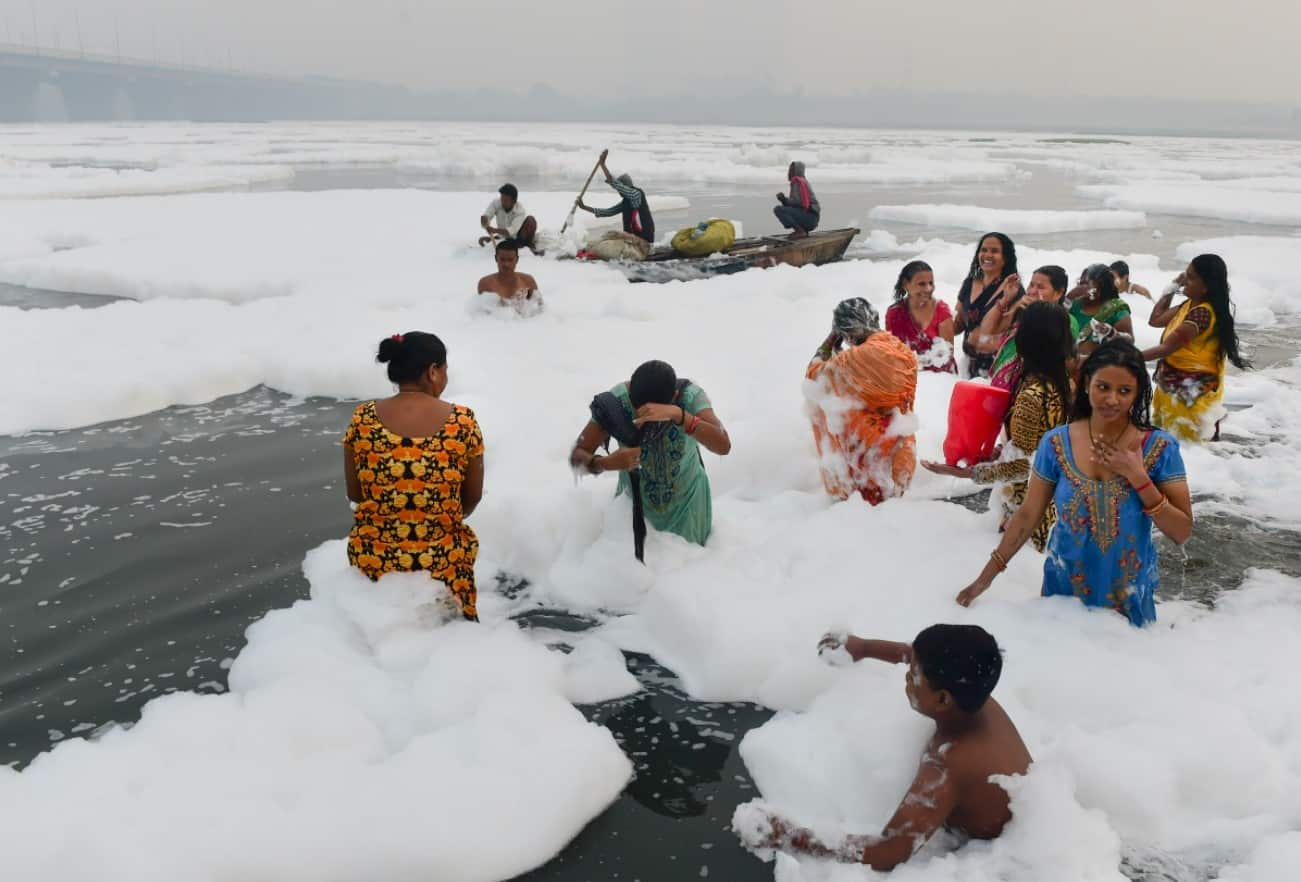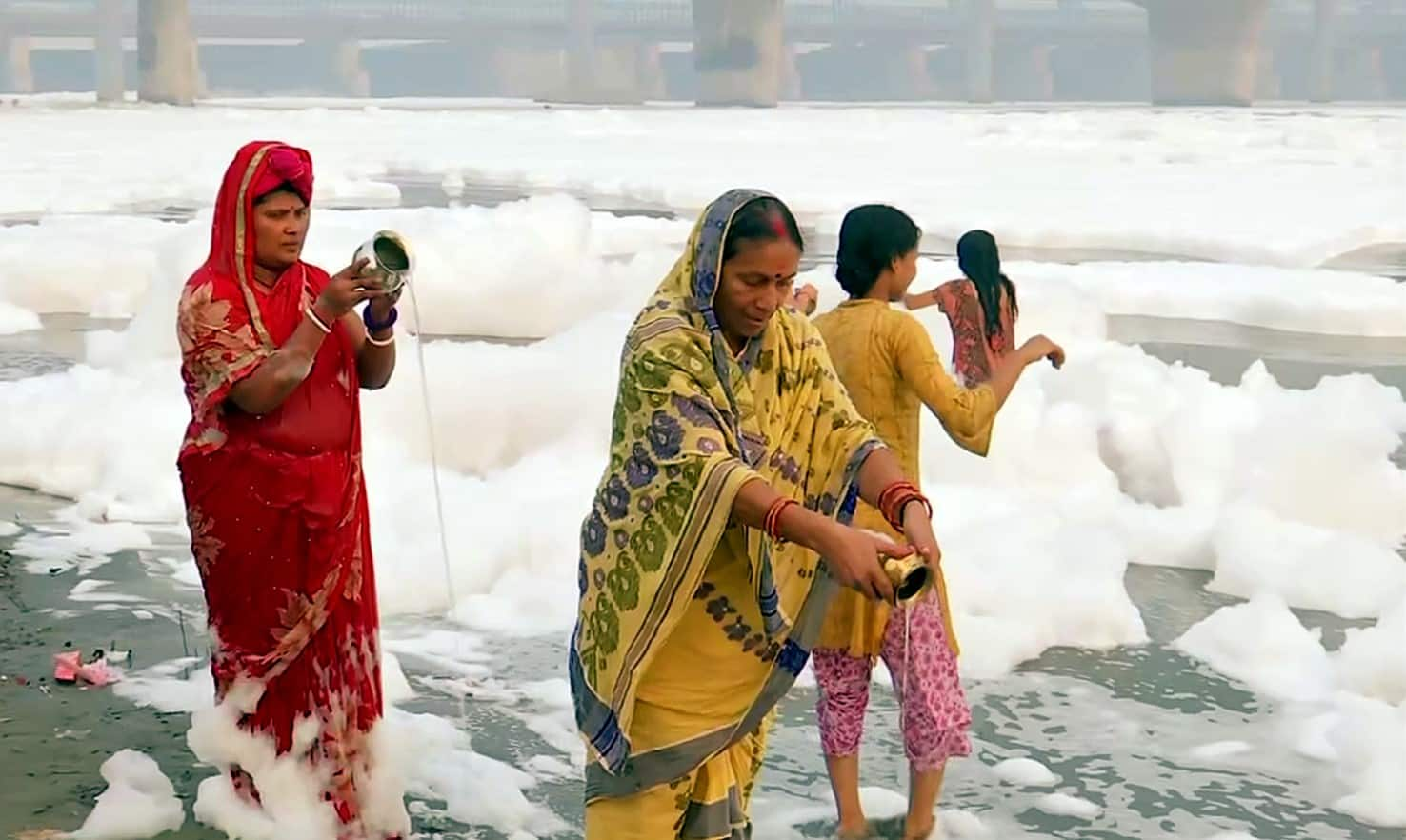Toxic froth continues to float in Delhi's Yamuna river, here's what's causing it
On Monday, devotees offered prayers at the banks of the foam-coated Yamuna near Kalindi Kunj as part of their four-day Chhath Puja celebrations.
Trending Photos
) Photo: Reuters
Photo: Reuters New Delhi: Pictures and videos showing devotees taking a dip in Delhi's Yamuna river that had a thick layer of toxic foam are going viral on the Internet. The devotees also offered prayers at the banks of the foam-coated Yamuna near Kalindi Kunj as part of their four-day Chhath Puja celebrations on Monday (November 8, 2021).
However, it is not the first time that Delhiites have witnessed toxic foam floating on the surface of the Yamuna river as the problem has plagued the national capital before as well.

According to experts, the presence of phosphates and surfactants in untreated sewage from Delhi, Haryana and Uttar Pradesh is a major reason behind frothing in the river.
The city's water supply was also affected recently due to a rise in ammonia levels in the Yamuna, which, notably, had increased to 3 ppm.
Press Note !!@htTweets @timesofindia @NBTDilli @TheDailyPioneer @ANI@PTI_News @JagranNewspaper @PunjabKesariCom @DDNewslive @ABPNews pic.twitter.com/Aq9gkfEyWz — Delhi Jal Board (@DelhiJalBoard) November 6, 2021
The 22-kilometre stretch of the Yamuna between Wazirabad and Okhla accounts for around 80 per cent of the pollution load in the river.
Untreated wastewater from unauthorised colonies and the poor quality of effluent discharged from Common Effluent Treatment Plants (CETPs) and sewage treatment plants (STPs) within Delhi is reportedly also one of the major reasons behind pollution in the river.
24 STPs don't meet prescribed standards for wastewater
On average, 24 out of the 35 STPs in the national capital did not meet the prescribed standards for wastewater over the last one year, as per the government data. Of the 13 CETPs in industrial areas across Delhi, only six comply with the DPCC standards for wastewater on an average.
Delhi generates around 720 million gallons of wastewater a day and the 35 STPs located at 20 locations across Delhi can treat up to 597 MGD of sewage and have been utilising around 90 per cent of their capacity.

In January this year, the Delhi government had told the National Green Tribunal the up-gradation of STPs in Uttar Pradesh, Haryana and Delhi to "substantially" reduce foaming in the Yamuna will take three to five years depending upon the availability of land and funds.
In a report submitted to the Union Jal Shakti Ministry in July, the Delhi government had said that the Yamuna cannot become fit for bathing in the absence of a minimum environment flow in the river. According to the International Union for Conservation of Nature, an environmental flow is the water provided within a river, wetland or coastal zone to maintain ecosystems and their benefits where there are competing water uses and where flows are regulated.
The Delhi government had also prepared a nine-point action plan last year to prevent frothing in the river. The plan lays down targets to be achieved by various agencies, including the Delhi Jal Board, Delhi Development Authority and municipal corporations, to prevent the discharge of untreated wastewater in the river.
Politics over frothing in Yamuna
Meanwhile, the Bharatiya Janata Party has alleged that the Aam Aadmi Party government did not allow Chhath Puja celebrations on the Yamuna banks to hide the 'pathetic' state of the river, while AAP's Gopal Rai and Raghav Chadha blamed the BJP governments in Uttar Pradesh and Haryana for the frothing in the river.
BJP MP Manoj Tiwari, who rode a boat in the foam-covered Yamuna, alleged that the AAP government did not allow Chhath Puja on its banks because it wanted to cover up the frothing in the river caused by high pollution load.
"(Delhi Chief Minister) Arvind Kejriwal has been saying since 2013 that his government will make the Yamuna fit for bathing in five years. Today, Delhi's air and water both are poisonous. They did not allow Chhath celebrations on the Yamuna so that no one can see how poisonous the river has become," he claimed.
pic.twitter.com/TBCjRDsAY6 — Manoj Tiwari (@ManojTiwariMP) November 8, 2021
Reacting to it, Environment Minister Gopal Rai blamed the BJP-led Haryana government for the toxic foam in the river and said leaders of the saffron party here should seek answers from the neighbouring state.
"Manoj Tiwari should ask the BJP government in Haryana (about the frothing). Delhi doesn't release poisonous water in the Yamuna, Haryana does," he said.
AAP leader and Delhi Jal Board Vice Chairman Raghav Chadha claimed that Haryana and Uttar Pradesh have been releasing around 155 million gallons of untreated wastewater a day in the river through Najafgarh and Shahdara drains.
"This water containing a lot of organic waste, chemicals and detergents fall from a height at the Okhla barrage which leads to the formation of foam," he said.
Besides, paper and sugar industries in Meerut, Muzaffarnagar, Shamli and Saharanpur in Uttar Pradesh also release untreated wastewater containing surfactants into the Yamuna through the Hindon Canal at Okhla Barrage near Indira Kunj, Chadha said.
While the Delhi government has been working to upgrade its sewage treatment plants to meet the revised standards of the Delhi Pollution Control Committee (DPCC), Uttar Pradesh and Haryana should do their bit in keeping the river clean, he added.
Yamuna pic.twitter.com/y8f89O3ikR — AAP (@AamAadmiParty) November 8, 2021
This is to be noted that the Arvind Kejriwal-led Delhi government had in June banned the sale, storage, transportation, and marketing of soaps and detergents not conforming to the latest BIS standards to curb pollution in the river.
(With PTI inputs)
Stay informed on all the latest news, real-time breaking news updates, and follow all the important headlines in india news and world News on Zee News.
Live Tv







)
)
)
)
)
)
)
)
)
)
